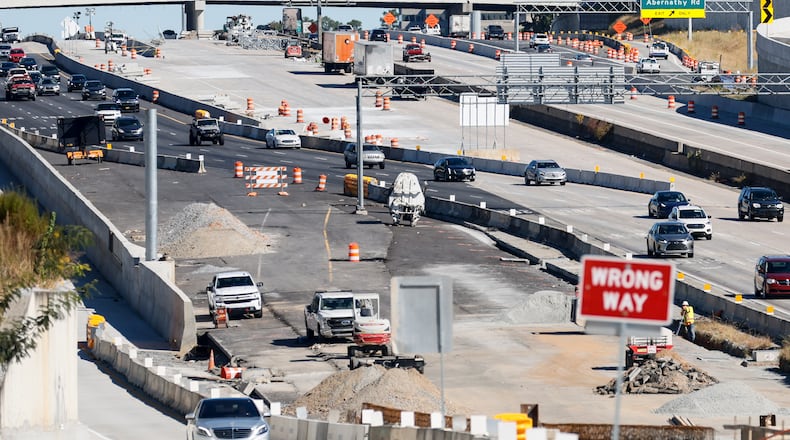After more than a year of delays, the Georgia Department of Transportation will close lanes for construction on the top end of the Perimeter beginning Saturday, the agency has confirmed.
GDOT will close one eastbound lane of I-285 between Roswell Road and Ashford Dunwoody Road on Saturday. As soon as a week later, it will close one westbound lane along the same stretch of highway. The closures are expected to last at least eight months.
The Atlanta Journal-Constitution reported earlier this week that the first closure could come as soon as this weekend. On Wednesday, GDOT spokesperson Natalie Dale confirmed the closure will take place as planned.
The closures come as construction of the new I-285 interchange at Ga. 400 enters its final phase. GDOT has been rebuilding the interchange for five years, and work is expected to continue until the second half of 2023.
In addition to the new interchange, the $800 million project includes a system of new collector-distributor lanes along both highways, a new diverging diamond interchange at Abernathy Road and a new bridge at Mount Vernon Highway. It also includes new I-285 bridges over Glenridge Drive, Ga. 400 and Peachtree Dunwoody Road.
The construction of the three I-285 bridges will require GDOT to close lanes. The agency has pledged to keep at least three lanes open in each direction during the day, though Dale said fewer lanes could be open late at night.
The work is expected to cause major traffic headaches for the hundreds of thousands of people who travel daily through the interchange. GDOT recommends motorists avoid the area if possible. But Dale said the interchange accommodates so many people traveling to so many destinations that it’s impossible to recommend any particular alternative routes.
“There’s no one right answer,” she said. “You’ve got 250,000 people coming from a different place and going to a different place.”
Instead, GDOT advises motorists to work from home if they can, take MARTA if they’re able or use navigational apps to find the best route. If they must travel through the construction zone, GDOT advises motorists to give themselves plenty of extra time — a trip could take an hour longer than usual on a bad day.
GDOT originally planned to close the lanes last year, but it decided to wait until more of the interchange project was complete to allow new lanes to accommodate more traffic.
I-285 lane closures: How to cope
Lane closures on I-285 are expected to cause major traffic problems in the months ahead. The Georgia Department of Transportation advises motorists to consider:
- Working from home if possible.
- Taking MARTA if you’re able.
- Using navigational apps to find the best alternative route for your trip.
- Allowing yourself plenty of extra time if you must travel through the construction zone.
AJC coverage of the I-285 interchange at Ga. 400
The Atlanta Journal-Constitution will report news updates and provide additional helpful information on this project. For updates, follow reporter David Wickert on Twitter @dwickert. For traffic information, follow @ajcwsbtraffic.
Oct. 2022: Lane closures on I-285 to stymie traffic for at least 8 months
Sept. 2021: Major I-285 lane closures near Atlanta delayed
April 2019: Extra work delays I-285/Ga. 400 interchange project
Nov. 2017: Major work begins on one of metro Atlanta’s worst traffic bottlenecks
About the Author
Keep Reading
The Latest
Featured




